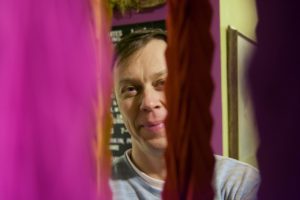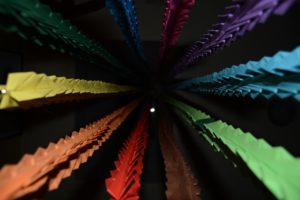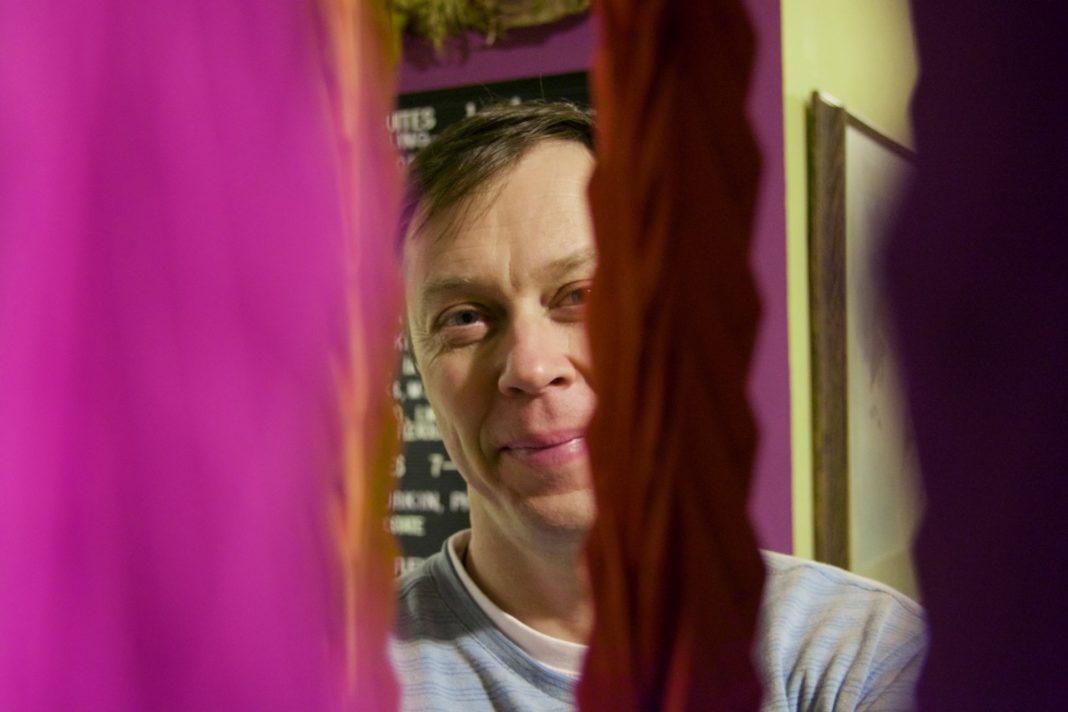Submitted by Leslie Demich
It began as the tenderest flutter of an idea: fold 1,000 origami cranes as a wish for all people to find peace and happiness. Five years later, Lacey-based massage therapist Todd McLendon has completed the task.
Arranged in long, colorful strands of 100 cranes each, the collection now graces the second floor lobby of the Marston Center in Lacey. Each strand measures ten feet in length; all ten strands are suspended from the lobby skylight.
The seed for the idea embedded itself even further back in time. While working as a teaching assistant in Chelan in 1996, McLendon introduced his first and second graders to the story of Sadako Sasaki, a Japanese girl who was two years old when the United States dropped the atomic bomb on her home town of Hiroshima. She survived, but the radiation exposure caused her body to develop leukemia 10 years later.

Moved by an ancient Japan legend that says, if you fold 1,000 paper cranes, the gods will fulfill your wish, Sadako set about the task of folding her cranes in hopes of surviving her illness. Sadly, she did not survive, but her memory lives on. A statue of Sadako stands in Hiroshima Peace Memorial Park, honoring all the children who died as a result of the bombing. At the foot of the statue is a plaque that reads, “This is our cry. This is our prayer. Peace in the world.”
It wasn’t until 2012 that the idea of folding 1,000 cranes fully hatched for McLendon. “I had just finished grad school, and I didn’t feel settled. I was not at peace, and I wanted happiness. I knew that having either was only possible if I also wished for peace and happiness for my entire community. When everyone has peace and happiness, everyone does better.” That’s when he remembered the Thousand Paper Crane legend as a means of asking that his wish come true.
Each crane takes a while to fold, so McLendon had to carve out time to work on the project. He folded five or 10 cranes between client appointments; he folded in the evenings when he had some free time; he folded while visiting family back in South Dakota. Still, it took five years to finish all 10 strands.
“As I folded, I settled into a meditation focused on being a creator creating the created for the benefit of the Creator,” McLendon explains.

McLendon dedicated his project to two people who are near and dear to his heart. The first person is his mentor and friend, Randy Marston. “Randy has been such an inspiration and support to me through the years. I treasure his friendship.” For this reason, the piece hangs in the second floor lobby of the Marston Center, where it will remain through Easter.
The second person McLendon dedicated his project to is his mother, a nurse in Sioux Falls, South Dakota. “My mom developed lung cancer in April 2016. I couldn’t be with her, so we talked over the phone a lot. Not knowing what the outcome would be, I learned to find happiness at the bleakest of times.” His mom finished her chemotherapy in July 2016. That following Christmas, Todd was able to go back to South Dakota for a visit. He brought his unfinished project with him, where he continued working on it. “I wanted my mom to see it before anything else happened.” Today, she is healthy and well.
The cranes will eventually make their permanent home with his mom. Until then, McLendon hopes people will come by the Marston Center to see the collection. “I hope the cranes will awaken a sense of awe in others and help them find a path to their own growth and reawakening,” he says.
Truth be told, McLendon’s project actually includes seven extra cranes, which float above the other 1,000. Two of the seven are white and yellow. They were the first cranes McLendon ever made, and they represent the beginning of creation. Two of them are larger than the others; they represent the “two-ness” of life. The remaining three are green; they are made of the extra sheets that came in his origami kit. “I believe no one should be left out of a community, so I included them.”
McLendon has some good advice for others who might like to take on such a project. “Be dedicated to the dream you are working to bring about, and hold that discipline close to you,” he says. The practice of folding done in this way then becomes almost Zen-like. “Before you know it, you’ve folded 20, then 100, then 1,000.”
He also suggests not getting too hung up on perfection. “Don’t worry too much about how they’re turning out. Let them reveal themselves as they are. Just let go.” McLendon found early on that each crane had its own unique shape. “Yet they all came together into harmony. I love every single one of them, even the ones that are imperfect.”
On a practical note, he suggests folding a few in one color and then switching to another color to stave off monotony. “I folded all 100 green cranes before making that adjustment to my routine, and that was a bit overwhelming.”
McLendon says origami is something just about anyone can do. “If you can hold a pencil, you can fold paper cranes.”
You can purchase origami kits at most craft stores and online. Each kit contains all the paper you’ll need to make 1,000 cranes, along with instructions on how to fold them. McLendon says the instructions that come with the kits can be a bit confusing, but there are a number of easy-to-follow videos available online. The kit he used had papers cut in three-inch squares, but you can also find kits with papers cut in two-inch squares. “The smaller papers will make much shorter, lighter strands,” McLendon says. “The larger papers make larger cranes that assemble into much longer, heavier strands.”
The cranes will be on display in the Marston Center until at least Easter. Visitors are welcome to stop by during normal hours to view them at 677 Woodland Square Loop SE, in the second floor lobby. The Marston Center is home to approximately 45 health and wellness practitioners, including chiropractic care, mental health counselling, Jin Shin Jyutsu, massage therapy, coaching and acupuncture. To explore the full array of practitioners, visit the Marston Center website.





















































